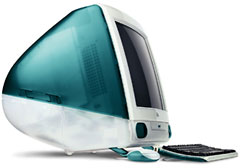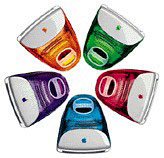Using up-to-date technology (this was 1997/8), Apple created a worthy
successor to the original Macintosh as a fully integrated computer.
No separate monitor, no rat's nest of power cords, and no external
drives necessary.
The distinguishing feature of these four models is a
tray-loading CD-ROM drive. Apple didn't offer any CD-RW or DVD-ROM
options.
 The
original iMac was introduced in May 1998 and shipped in August.
With a 233 MHz PowerPC 750 (the same G3 CPU used in the beige Power Mac G3), 32 MB of RAM (officially
expandable to 256 MB - and possibly to 768 MB using a 512 MB SL2 module
plus a low-profile 256 MB SL2 module), a 4 GB hard drive, a 24x CD-ROM,
ethernet, stereo speakers, and an integrated 15" multiscan monitor,
there wasn't much you'd need to add to the US$1,299 iMac.
The
original iMac was introduced in May 1998 and shipped in August.
With a 233 MHz PowerPC 750 (the same G3 CPU used in the beige Power Mac G3), 32 MB of RAM (officially
expandable to 256 MB - and possibly to 768 MB using a 512 MB SL2 module
plus a low-profile 256 MB SL2 module), a 4 GB hard drive, a 24x CD-ROM,
ethernet, stereo speakers, and an integrated 15" multiscan monitor,
there wasn't much you'd need to add to the US$1,299 iMac.
Beyond recapturing a vision and providing the same usability
other Macs do, the iMac broke new ground for an Apple desktop with
its Bondi (pronounced bond-I) blue color, two USB (universal serial
bus) ports and an infrared port - and no floppy drive, SCSI
connector, serial ports, or plugs for ADB devices.
Revision B
Just two months after the iMac first shipped, Apple released
the Rev. B iMac, which came with Mac OS
8.5. Video RAM was increased from 2 MB to 6 MB, and the
power button could now be used as a reset switch.
The Rev. B looks just like the original iMac.
iMac G3/266
 With the Rev. C
iMac, Apple moved away from Bondi blue and adopted five fruity
colors: tangerine, grape, lime, blueberry, and strawberry. The
Janury 1999 model ran at 266 MHz and had a 6 GB hard drive - 50%
larger than earlier iMacs.
With the Rev. C
iMac, Apple moved away from Bondi blue and adopted five fruity
colors: tangerine, grape, lime, blueberry, and strawberry. The
Janury 1999 model ran at 266 MHz and had a 6 GB hard drive - 50%
larger than earlier iMacs.
The new iMac sold for US$1,199 and lacked the infrared port
found on earlier revisions.
iMac G3/333
The Rev. D iMac, introduced in April
1999, had the same color options as the Rev. C, but it had a 333
MHz CPU for 25% more processing power at the same price.
The tray-loading iMacs were replaced by slot-loading models in
Oct. 1999. These were not only faster, but in many ways they were
far superior machines for running Mac OS X.
Mac OS X
If you have a hard drive over 8 GB in size, you must
partition it, and the partition containing OS X must be
completely within the first 8 GB of space or you will
not be able to run OS X. (If you are creating the
partition within OS X, it must be 7.45 GB or smaller as
reported by Disk Utility, because sometimes a GB is billion bytes
and sometimes it's 1,073,741,824 bytes.)
While Apple claims early versions of OS X can run on 128 MB of
memory, we strongly recommend you go to at least 256 MB if you plan
to run OS X on a tray-loading iMac.
Be sure to read and follow Apple's "Read Before You Install"
install instructions to increase the likelihood of getting
OS X installed and running on the first try.


 With
With 
